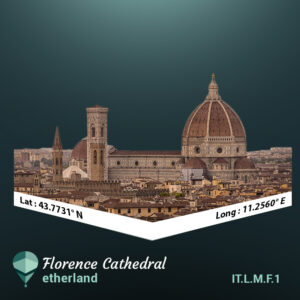 The Florence Cathedral, or Cathedral of Santa Maria del Fiore, is one of the largest buildings of medieval Europe and a UNESCO World Heritage Site. It was constructed in 1296 as the city's second cathedral to accommodate the growing population. As of today, it is the third-largest church in the world. Its most peculiar dome requires the visitors to climb 463 steps to reach the top of the 114.5 meters high cupola, where they will be awarded astonishing panoramic views of Florence.
The Florence Cathedral, or Cathedral of Santa Maria del Fiore, is one of the largest buildings of medieval Europe and a UNESCO World Heritage Site. It was constructed in 1296 as the city's second cathedral to accommodate the growing population. As of today, it is the third-largest church in the world. Its most peculiar dome requires the visitors to climb 463 steps to reach the top of the 114.5 meters high cupola, where they will be awarded astonishing panoramic views of Florence.
Florence Cathedral, or, to use its full name, the Cattedrale di Santa Maria del Flore, meaning the Cathedral of Saint Mary of the Flower, is a Gothic-style cathedral that dominates the skyline of central Florence. It first entered construction in 1296 and is a symbol of the Italian Renaissance, which was starting at the time, with Florence at its very core, and which reached its peak in the fifteenth century around the time that the cathedral was finally finished.
At the time of its initial construction in the late thirteenth century, Florence was governed as a republic and was a small Tuscan city-state ruled effectively by merchant elites. Thus, the town council approved a design by the architect Arnolfo di Cambio, in the mid-1290s for a new cathedral church that would symbolize the civic pride of Florence. Construction work began in 1296 and lasted 140 years.
Over the years, many of the leading figures of the Renaissance worked on the cathedral. For instance, in 1334, the famed painter and architect Giotto began to oversee some of the work, and it was under his direction the bell tower or campanile was developed. Much of the lower building was completed by about 1380, measuring 153 meters by 90 meters at its extremities and covering 89,000 square feet. But there was still a lack of decision about how the roof should be constructed.
The monument's most famous part is the dome that surmounts the building. Plans had been in place to install a roof since the fifteenth century, but it was not until 1418 that the work was handed over to the Italian architect, Filippo Brunelleschi. Brunelleschi had studied widely on Ancient Roman building methods, including the extant works of Vitruvius, a famous Roman architectural writer of the first century BC, as well as having examined the physical remains of some ancient buildings in Rome such as the Pantheon, a Roman temple built in the second century AD. As a consequence, Brunelleschi became convinced that he could place an enormous dome on top of the cathedral modelled on that of the Pantheon. It involved many technical challenges to insure that the dome could be supported. When it was finally accomplished, with the addition of a lantern at the top of the dome decades later, the total height of it was 114.5 metres, making it one of the tallest buildings in the world in the late fifteenth century.
Today the monument has been added to again significantly, with the addition of a Gothic revival façade during the nineteenth century. In 1982 the cathedral was designated as a UNESCO World Heritage Site and it receives over seven million visitors on an annual basis, making it one of Italy’s most popular tourist attractions.